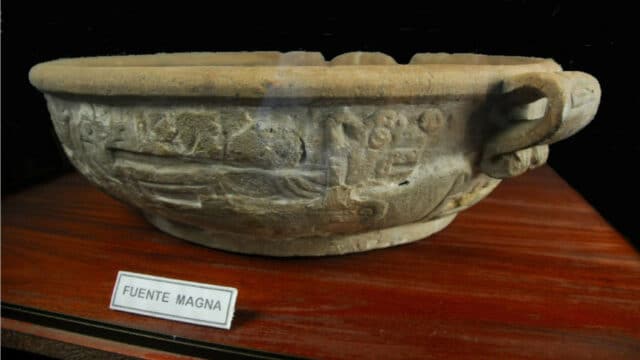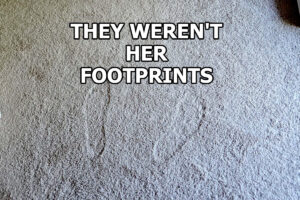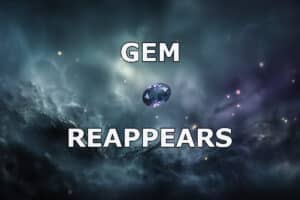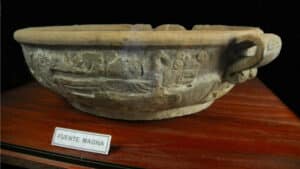
The Fuente Magna bowl, a large stone vessel discovered near Lake Titicaca, Bolivia, in the 1950s, stands as one of archaeology’s most polarizing artifacts.
Hailed by some as evidence of ancient transoceanic contact between Mesopotamia and South America, it is dismissed by others as a potential forgery or misinterpretation. Its intricate carvings and alleged Proto-Sumerian inscriptions have fueled decades of debate, raising questions about ancient human connections, the limits of archaeological interpretation, and the role of scientific bias in evaluating unconventional claims.
This article traces the bowl’s discovery, examines the claims and criticisms surrounding it, and explores the broader implications of its unresolved status, leaving readers to ponder whether it is a genuine relic or an archaeological enigma.
QUICK ANSWER
What is the Fuente Magna Bowl?
The Fuente Magna Bowl is a stone vessel found in 1950 near Lake Titicaca, Bolivia, with alleged Proto-Sumerian inscriptions suggesting ancient Mesopotamian contact. Mainstream archaeologists dispute this, arguing the engravings are likely local Andean designs. Its authenticity remains debated due to unclear provenance.
Discovery and Initial Claims
In the 1950s, a worker on the CHUA Hacienda, a property of the Manjon family located 75-80 km from La Paz, Bolivia, accidentally unearthed a large stone bowl near Lake Titicaca, a region known for its rich archaeological heritage, including the Tiwanaku and Pukara cultures.
The artifact, crafted from earthen-brown stone, features detailed engravings of zoological motifs and anthropomorphic figures, both inside and out. Bolivian archaeologist Max Portugal Zamora, informed of the find around 1958-1960 by his friend Pastor Manjon, named it the “Fuente Magna.” The bowl was later transferred to the Museo de los Metales Preciosos in La Paz, where it remains on display.
The bowl’s significance emerged from its alleged inscriptions, which some researchers claimed resembled Sumerian cuneiform, a writing system used in ancient Mesopotamia (modern-day Iraq) around 3000-2000 BC. Dr. Alberto Marini, described as an authority on ancient Mesopotamian languages, reportedly translated the inscriptions as Sumerian, suggesting a direct link to the Sumerian civilization. In a more detailed analysis, Dr. Clyde A. Winters, a former professor of education, identified the script as Proto-Sumerian, akin to Proto-Elamite scripts used in ancient Mesopotamia. Winters employed the Vai script, a 19th-century West African writing system, to decipher the inscriptions, claiming they described rituals honoring a goddess named Nia, linked to the Egyptian goddess Neith and the Linear A term from Minoan Crete.
Winters’ translation, published on various online platforms, suggested the bowl was used for libations to request fertility and offer thanks for the region’s abundant resources. He proposed that Sumerians, known for their seaworthy ships that sailed to the Indian Subcontinent, may have reached Bolivia after 2500 BC, possibly navigating around South Africa and across the Atlantic or Pacific.
This hypothesis was supported by researchers like Bernardo Biados and Freddy Arce, who interviewed a local named Maximiliano, who claimed to have found the bowl and used it to feed pigs, unaware of its significance. These claims positioned the Fuente Magna as a potential “Rosetta Stone of the Americas,” suggesting ancient transoceanic contact long before Columbus.
Criticisms and Challenges
The Fuente Magna’s claims have faced rigorous scrutiny from mainstream archaeology, with critics highlighting several issues that undermine its authenticity and the interpretations of its inscriptions.
Lack of Provenance
The bowl’s discovery lacks archaeological context, as it was found accidentally without controlled excavation. This absence of provenance—details about its find-site, stratigraphy, or associated artifacts—makes it impossible to verify its age or cultural affiliation. As noted in Archaeology Review, there is “no provenience. None. Nada. Zilch,” only anecdotal accounts of its discovery. This raises suspicions that the bowl could be a modern creation or an altered artifact planted to attract attention. The lack of radiocarbon dating or chemical analysis of its materials further complicates efforts to establish its antiquity.
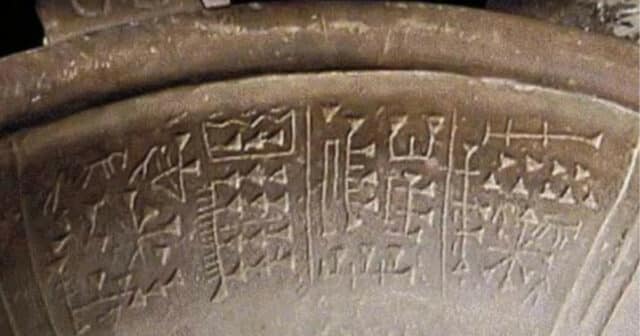
Questionable Inscriptions
The alleged Proto-Sumerian inscriptions are a focal point of criticism. Mainstream experts, such as Alexander H. Joffe, argue that the engravings are not cuneiform but “geometric filler or deliberate gibberish,” possibly produced by local Andean cultures like Tiwanaku (ca. 200-1000 CE). The Archaeology Review analysis details specific issues: the inscriptions are sloppy, with wedges oriented incorrectly and mixed with non-cuneiform signs, unlike the structured rows and columns of genuine cuneiform. Symbols like DINGIR/AN and ASH appear but are often distorted or unrecognizable, and terms like “Proto-Sumerian” are not recognized in mainstream scholarship, as Sumerian was expressed through cuneiform, not a distinct proto-script.
Clyde Winters’ use of the Vai script, developed in the 19th century AD in Liberia, is particularly problematic. This anachronism renders his decipherment scientifically untenable, as the Vai script could not exist in 2500 BC. His translations, which describe rituals for the goddess Nia, are criticized as speculative and unsupported by peer-reviewed linguistic analysis. For example, symbols he identifies as Sumerian do not match known cuneiform sign lists, and his claim of a goddess Nia lacks independent corroboration. Similarly, Alberto Marini’s work, published in the Epigraphic Society Occasional Publications, is dismissed due to the society’s reputation for promoting controversial, non-peer-reviewed theories by figures like Barry Fell.
Absence of Sumerian Evidence
The hypothesis of Sumerian settlement in Bolivia lacks archaeological support. No other artifacts, settlements, or cultural markers indicate Mesopotamian presence in South America. Sumerians were known for coastal trade routes to North Africa and India, but there is no evidence of transoceanic voyages across the Atlantic or Pacific. The Archaeology Review notes that shared technological advancements, like the wheel, are absent in pre-Columbian South America, further undermining the transoceanic contact theory. The cultural context of the Titicaca Basin, dominated by Andean cultures like Tiwanaku and Pukara, shows no trace of Mesopotamian influence, and the bowl’s iconography aligns more closely with local styles.
Potential Forgery
Some critics suggest the Fuente Magna may be a forgery or hoax. The sloppy execution of the inscriptions, the mix of unrelated scripts (e.g., Phoenician-like and cuneiform-like signs), and the lack of earlier archaeological context at the find-site (Tiahuanaco, founded ~100 AD) support this view. The bowl’s discovery by a construction worker for the Manjon family, with no prior record of Tiahuanaco occupation dating to 2500 BC, adds to suspicions. The Archaeology Review posits that the creator may have seen cuneiform in media, such as a 1948 Life Magazine article on Babylonian artifacts, and attempted to replicate it.
Non-Mainstream Scholarship
The primary proponents of the Fuente Magna’s Sumerian claims—Marini, Winters, and associates—are not recognized as mainstream scholars. Marini’s publication in the Epigraphic Society, known for fringe theories, lacks credibility in academic circles. Winters, a former education professor, has been criticized for bypassing peer review and making unsubstantiated claims, such as deciphering the Indus Valley script. The absence of peer-reviewed studies by acknowledged experts in ancient languages, as noted in a Reddit discussion, further isolates the bowl from scholarly acceptance.
Never Miss A Paranormal Story!
Newsletter subscribers get insider access to the latest paranormal posts!
Your email is safe with us and you can unsubscribe at any time!
Scientific Bias and the Need for Open Inquiry
The Fuente Magna’s dismissal by mainstream archaeology raises broader questions about scientific bias and the treatment of unconventional claims. Archaeology, like any scientific discipline, is shaped by paradigms that can resist radical ideas. Colin Renfrew, a prominent archaeologist, has acknowledged that the archaeological establishment can be “set in its ways and resistant to radical new ideas” (Pseudoarchaeology). However, he clarifies that pseudoarchaeological theories, like those surrounding the Fuente Magna, are rejected due to insufficient evidence, not merely bias.
Critics like Garrett G. Fagan and Kenneth L. Feder argue that engaging with pseudoarchaeologists is futile, as they often deny logic and evidence, comparing such dialogues to debates between evolutionary biologists and creationists (Pseudoarchaeology). Conversely, Cornelius Holtorf advocates for constructive dialogue, criticizing the “opinionated and patronizing” tone of some critics (Pseudoarchaeology). This tension highlights the danger of bias: while rigorous standards are essential, dismissing unconventional claims without thorough examination risks stifling discovery.
The Fuente Magna’s lack of peer-reviewed validation does not automatically discredit it. Archaeological history includes examples where initially dismissed ideas, such as the antiquity of Maya writing, gained acceptance with new evidence. However, the bowl’s claims face significant hurdles: the absence of archaeological context, the methodological flaws in its translations, and the lack of corroborating evidence align it with pseudoarchaeological narratives. As noted in Archaeology Southwest, biases can shape interpretations, but the scientific method demands compelling data to overturn established views, which the Fuente Magna currently lacks.
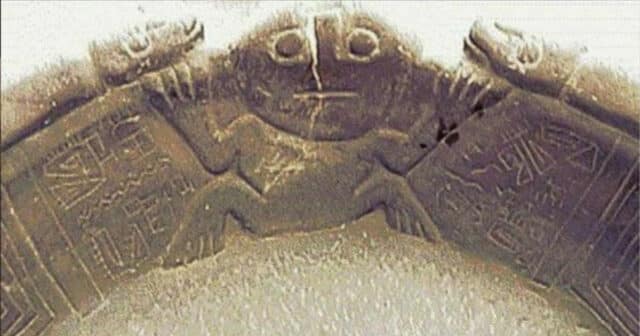
Conclusion: An Unresolved Enigma
The Fuente Magna bowl remains a captivating mystery, embodying the complexities of archaeological interpretation and the clash between mainstream science and alternative theories. Its discovery near Lake Titicaca, its intricate carvings, and the bold claims of Sumerian inscriptions have inspired fascination and debate. Yet, mainstream archaeology leans heavily against its authenticity, citing the lack of provenance, the questionable nature of its inscriptions, and the absence of evidence for Sumerian contact with South America. Critics suggest it is more likely a local Andean artifact, possibly from the Tiwanaku culture, or a modern fabrication designed to provoke intrigue.
Despite these challenges, the bowl’s story underscores the importance of open inquiry. Scientific bias can hinder exploration, but the burden of proof lies with proponents to provide rigorous evidence. The Fuente Magna’s authenticity—whether a genuine relic of ancient transoceanic contact or a misunderstood creation—remains unproven. It stands as a testament to the enduring allure of the unknown, inviting readers to weigh the evidence and decide for themselves.
Tables: Summary of Claims and Criticisms
| Aspect | Claims | Criticisms |
|---|---|---|
| Inscriptions | Proto-Sumerian cuneiform, deciphered using Vai script, linked to goddess Nia | Not cuneiform, likely geometric designs; Vai script anachronistic; translations speculative |
| Cultural Connection | Sumerian settlement in Bolivia after 2500 BC via transoceanic voyages | No evidence of Sumerian presence; local Andean cultures more likely origin |
| Provenance | Found accidentally in 1950s near Lake Titicaca | No controlled excavation; no context or dating; possible forgery |
| Scholarship | Supported by Marini, Winters, Biados, and Arce | Non-mainstream scholars; no peer-reviewed studies; Epigraphic Society discredited |
Implications and Legacy
The Fuente Magna bowl serves as a case study in the challenges of distinguishing genuine archaeological discoveries from pseudoarchaeological claims. It highlights the need for rigorous scientific methods while cautioning against dismissing unconventional ideas too hastily. Its unresolved status invites further research, though any future claims must address the current evidential gaps. Until then, the bowl remains a symbol of the mysteries that continue to captivate archaeologists and enthusiasts alike.

